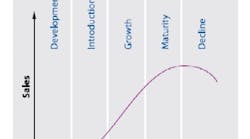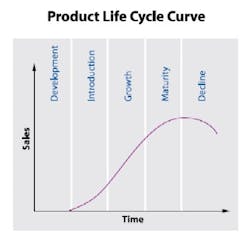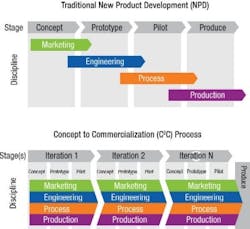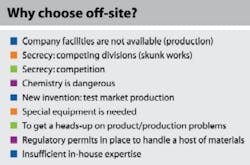Innovation, whether through the development of new products or processes, has become crucial for companies in virtually every industry. New technology holds the key to competitive advantage and, perhaps, survival. Product life seems to be shorter and shorter (Figure 1).
Figure 1. The lifecycle of a product to stay in business a company needs a steady stream of new ideas.
For manufacturers, the problem is particularly acute because of the ease with which competitors can outsource production. No longer can mature companies, with established manufacturing bases, count on an economy-of-scale advantage as a barrier to entry from new competitors.
Since 1964, Pressure Chemical Co. (www.pressurechemical.com) has worked with hundreds of customers from the large multi-national corporations to small entrepreneurial start-ups, applying unique configurations of equipment and extensive chemical expertise. These efforts have often resulted in new products, processes and, at times, new business segments for the client company. As expected of developmental projects, however, many failed to produce a successful innovation, though, in retrospect, a large number of the attempts did yield substantial savings for the sponsoring client. Early failures have prevented a company from making large investments in a process that wouldnt work as anticipated or in a product that couldnt meet the performance and economic needs of the marketplace.
Weve been able to observe scores of successes, near misses, and failures the entire range of potential results, says Larry Rosen, CEO of Pressure Chemical. In an effort to improve our own internal processes, we began to examine the data closely and realized that we had learned to do things in a new and different way, having seen the best and the worst of all the organizational processes used by our customers. With the help of an outside consultant, Droz and Associates, (www.droz.com) we cataloged our new products and processes that illustrated a variety of circumstances, parameters and goals. The consultant found that our method was a radical departure from traditional budget-driven, stage-gate approaches (Figure 2).
Figure 2. The cyclic C2C approach can correct the trajectory of a product during development.
Although attempts have been made to improve the traditional method, such as the CPM (Critical Path Method), (http://en.wikipedia.org/wiki/Critical_path_method) a joint venture between DuPont and the Remington Rand Corp., the approach was flawed. The Japanese, perhaps driven by their respect for W. Edwards Deming, evolved a step-gate method that looks back periodically to correct the trajectory of a project. Still, something was lacking.
Droz helped us to conceptualize the approach in a graphic manner that illustrates the central distinction of this cyclic route from the traditional straight-line approach. The key benefits of this novel approach, which we call Concept to Commercialization (C2C), (www.presschem.com/guide.htm) are reduction in time, cost and risk, akin to a hat trick in hockey, according to Rosen.
The goal of a recent project, undertaken for a major international manufacturer, was the hydrogenation of a polymer for use in high-capacity data storage. This client chose to outsource the project because of the diversity of appropriately sized equipment available in our facility. The base polymer had been produced by the client in its large continuous production facility and the scope of work was limited to hydrogenation. Unfortunately, market testing of the target product revealed that its properties failed to meet expectations. Because it wasnt feasible to interrupt commercial production to produce small quantities of differentiated precursors for further work, the client faced abandonment of the project.
In discussions centered upon future windows of opportunity to process additional samples, the client was introduced to the variety of resources and interdisciplinary team of specialists that could be assembled to move the project forward without substantial delay. The proposal presented to the client expanded the scope of work to include creation of a small polymerization system and synthesis of the triblock coRandpolymer precursor. Within three weeks, the project was back on track and demonstrating the best features of the nascent C2C Method.
The C2C method
The C2C method has a number of key distinctions: Unlike traditional, linear models of product development, its a cyclical process where one cycle inputs into the next and where a variety of solutions move repeatedly through a range of stages. It integrates rapid prototyping and multidisciplinary teams to allow numerous, and nearly simultaneous, iterations. Inspired, in part, by approaches and techniques commonly employed in food industry test kitchens, this method requires a devoted team, incorporating all appropriate disciplines and allowing a broad range of process options for comparison and contrast as to efficacy, scaling and suitability.
This method typically postpones confirmation of a concept until several iterative cycles have been conducted, to preserve flexibility and to allow incorporation of new ideas into a synthesized set of solutions. Traditional approaches frequently focus early on a preferred outcome rather than permitting the open consideration of alternatives.
In C2C, numerous potential processes may be evaluated and ranked for strengths and weaknesses. Experimental work and iterative prototype testing determines the right combination of conditions for each potential stage or step in the process. By combining unit processes that are most promising, a new process train can be defined, installed and tested, incorporating the best attributes and practices of the variations considered. And, of course, as with tasting in a test kitchen, the product is sampled, analyzed and tested without delay.
Why outsource development?
Companies outsource work for many reasons, often expecting to reduce costs and time to completion or to resolve resource availability issues. Sometimes the reason is safety, secrecy or anticipated production problems (Figure 3).
Figure 3. The test-kitchen approach fulfills a niche-service in the chemical industry.
Many companies presume that cost is the easiest factor to assess and, consequently, they allow the purchasing department to evaluate the decision to make or buy developmental services. Unfortunately, many purchasing executives lack the information for an in-depth analysis and understanding of all relevant costs and risks. For example, in comparing the price quoted by an independent facility to an internal budget, a purchasing executive may ignore critical risk factors or competition for internal resources simply because that information is not presented to him.
Some companies have saved millions of dollars by employing outsourced facilities to take the risks in scale-up, notable among them, firms in the pharmaceutical industry. There are several examples in our database where the worlds foremost experts in a particularly narrow field of chemistry learned to their horror that the impossible does occur.
In one memorable case, a client company assured us that its fluorinated product was entirely stable and couldnt damage our all-glass, high-vacuum distillation system. The glassware was replaced. Had this work been performed in the clients facility, the notoriety and delays in incident investigation and equipment replacement might have had disastrous consequences for other products and work scheduled in their facility.
There are so many constraints for companies some initially unforeseen in new product development, says Mike Keenan, a retired senior chemist from Exxon who has worked and consulted on a number of projects at Pressure Chemical. Since many companies are committed to existing technologies, its difficult for them to have the equipment, capital and, sometimes, the mindset to develop new products and processes efficiently. And companies vary in their strengths. Some are superb at taking someone elses process and making it more efficient and effective. Others are better at discovering a new process from scratch. In any event, outsourcing certain stages of the product development process can bolster total development efforts, according to Keenan.
You need to develop new products outside of the typical constraints of manufacturing, preferably where you can brainstorm for ideas with operators, chemists, mechanics, engineers and regulatory specialists, Keenan added. You need to be in a place where change is anticipated and facilitated, not where change requires sign-off at several levels and can take weeks or months.
Changing equipment and process procedures are germane to the development process. Unanticipated issues arise during scale-up; its common to change equipment and conditions midway through the development process, even during the course of a reaction said Brandon Ritchie, a senior project manager at Pressure Chemical. Its much easier to change something in a well equipped pilot plant than in a clients production facility. Safety, flexibility and speed are everything in process development, he added. Pressure Chemicals project leaders are given full authority to accept client initiated changes in equipment and operating conditions so long as the change conforms to defined safety requirements.
For example, a new client project required some dramatic modifications to the distillation of a high melting monomer. The attempted distillation resulted in a lot of freezing in the process piping. The problem was solved by injecting an appropriate solvent into the overhead to deliver the product as a solution. We had the ability to modify the equipment quickly and to develop a new, highly successful process for the distillation, Ritchie said, adding that this preserved the delivery schedule for the product.
Regulatory issues
Large companies are well aware of the impact of federal, state and local regulatory issues in product and process development. Smaller companies, especially ones that do not manufacture novel chemical products, may be totally unaware of the regulations affecting new chemicals. An independent pilot facility that specializes in innovative materials maintains an awareness and working knowledge of the rules, limitations and regulations impacting its customers development efforts. For those without the internal regulatory capability, an early consultation with an independent pilot facility should at least identify regulatory issues.
Companies will often base their new product specifications on their lab scale work with research-grade reagent chemicals in the lab. These self-imposed, tentative standards may not be feasible on a commercial scale but, frequently, provisional as they may be, these specifications take on the weight of authority and nobody remembers why. A major component of the innovation process, applicable to new chemicals, is the appropriate product specification and the techniques by which they are to be measured. Unnecessarily tight specifications may limit the market because of excessive costs while inappropriate specifications may allow a process to be scaled-up and commercialized before its ready.
A recent example of tentative specifications drawn too tightly comes from the development of a process to manufacture a novel cosmetics ingredient. The original lab work, performed in 100-ml. lab glassware, employed high purity reagent chemicals and produced a high purity product after high-temperature distillation. Unfortunately, a slow but steady decomposition at the necessary distillation temperature produced a highly undesirable and irritating byproduct. By changing the stoichiometry of the synthesis, using an excess of a reagent commonly employed in formulations that would include this product, the distillation step could be eliminated, increasing the yield and reducing cost.
Because the tentative specification had been prematurely communicated in product literature, the client was forced to delay acceptance of a change until its customers had agreed. Not only was the client saddled with the associated higher costs, but it was unable to meet the initial demand for its new product.
If you gear your process to making a high purity product, youve got to ask yourself: What is the cost to meet this level of purity? Sometimes it is best if the question is deferred and the answer postponed to the end of the development process, Ritchie said.
A flexible alternative
The traditional straight line, stage-gate approach to development has been the industry standard for many years. We believe the innovation process can be enhanced by using a cyclical process where multiple solutions, shepherded by a multi-disciplinary team, move through the development stages. Outsourcing offers a flexibility that is essential to introducing new ideas, throughout the development process creating a rich synthesis of solutions. By outsourcing work to the appropriate facility, companies will find that they can achieve a reduction in the time to market and the risk of failure while realizing a lower real cost of development. To learn more about product development and the Concept to Commercialization (C2C) process, visit www.pressurechemical.com.
Chuck Kenney is a marketing manager at Pressure Chemical Company in Pittsburgh, Pa.; E-mail him at [email protected].




